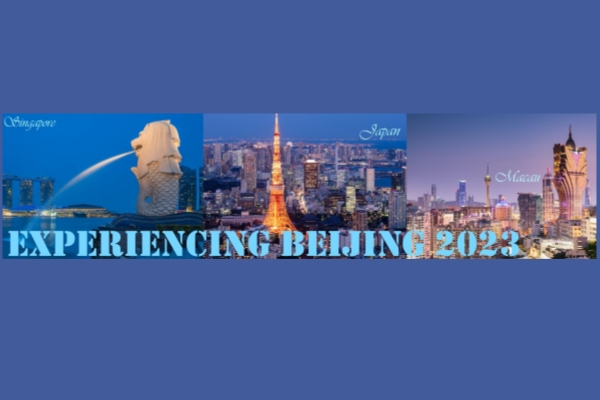Intangible cultural heritage enriches appeal of Beijing Wtown

A bird's-eye view of Beijing Wtown [Photo provided to chinadaily.com.cn]
Picture a water town in Beijing reminiscent of Wuzhen in Zhejiang with the Great Wall on your horizon.
By day, you can hike on the Simatai Great Wall, take a leisured stroll through the town's hundreds of buildings in the Ming and Qing (1368-1912) fashion, swim in an "infinity pool", enjoy afternoon tea in a slow boat, and acquire hands-on learning in local culture and crafts. By night, you can feast your eyes on the splendid music fountain show and drone light show before drifting away to serene nature sounds.
Beijing Wtown may immediately be the example that springs to mind. Opened in 2010, the site, roughly a two-hour drive from downtown Beijing, has gained traction among tourists from home and abroad and has become a popular destination for weekend romantic getaways and family vacations.
With a smorgasbord of intangible cultural heritage items for tourists to view and learn, the international resort was recognized as a national optimal project integrating tourism with intangible cultural heritage in 2022 by the country's Intangible Cultural Heritage Protection Association.

A collage of day and night views of the Simatai Great Wall in Beijing Wtown [Photo provided to chinadaily.com.cn]
"Tourist attractions today can no longer solely rely on sightseeing as people are seeking more quality tourism experiences. At Beijing Wtown, we have been exploring ways to deepen the integration between culture and tourism and improve service to achieve sustainable growth," noted Bu Chao, the resort's marketing director.
The resort has been committed to creating tourism products featuring intangible cultural heritage to promote heritage items among tourists, especially the young, and enrich their cultural experience, Bu said.
For example, in 2022, a summer camp featuring intangible cultural heritage experience was first held in Wtown. Children scaled the Simatai Great Wall and were given classes on Peking Opera and soft clay art.
We have handpicked some programs offered at the resort where you can try your hand at various intangible cultural heritage items and gain a deeper understanding of them.

Tourists make and color Beijing shayan (swallow) kites at Feng Zhi Wu in Beijing Wtown. [Photo provided to chinadaily.com.cn]
Making kites
At Feng Zhi Wu, a space dedicated to kite selling and teaching, tourists are set to be dazzled by a medley of kite designs, with Beijing shayan (swallow) kites being the most prominent ones. Here tourists can learn about the history of Shayan kites, make their own kites under the guidance of a craftsman and fly them high at the foot of the Great Wall.

Yongshun Dyehouse in Beijing Wtown offers tie-dyeing and weaving workshops. [Photo provided to chinadaily.com.cn]
Tie-dyeing and weaving
At the courtyard of Yongshun Dyehouse, tourists are first greeted by a majestic installation of cloths of various patterns, making it a popular place for photo shoots. Inside the dyehouse, they may see craftsmen dye calico in a huge pot with plant pigments. Tourists can participate in a tie-dyeing workshop to make their own tie-dyed pieces and learn to weave on a loom.

Tourists make paper and learn about movable type at Yinghua Academy in Beijing Wtown. [Photo provided to chinadaily.com.cn]
Making paper and movable-type prints
At Yinghua Academy, tourists can learn two of the four great inventions of ancient China – paper-making and printing. Here they can take classes to make paper that was invented by Cai Lun, an official in the Eastern Han dynasty (25-220) and print a work on their own with movable type invented by Bi Sheng during the Northern Song dynasty (960-1127)
Making lanterns
Lanterns in China date back more than 1,800 years and in 2006, gongdeng, or palace lanterns, were recognized as a national-level intangible cultural heritage. At Jian Kun Tang in Beijing Wtown, visitors can appreciate this heritage item and learn to make their own gongdeng with an in-house craftsman.
Making soft clay Lord Rabbit
In Beijing, Lord Rabbit, known as Tu'er Ye in Chinese, is not only a local handicraft symbolizing happiness and good luck, but also a popular clay toy for children during traditional festivals, especially the Mid-Autumn Festival. A Tu’er Ye store-workshop on the resort's Wangjing street provides tourists with a beginner-friendly course on making the Beijing mascot with soft clay.
Making shadow puppets
An ancient art of storytelling and entertainment, shadow play, or shadow puppetry, enjoys widespread popularity in China. In 2oo8, Beijing shadow play was selected as a national-level intangible cultural heritage. Tourists can visit the shadow play house in Wtown where they can learn to make a shadow puppet and bring it home after it is done.
Sporting a hanfu look
When in Wtown's quaint, elegant surroundings, few can resist the urge to don a hanfu garment as the traditional Chinese costumes seem to be able to immediately transport the wearer to an ancient period. That explains why so many Wtown tourists, mainly females and children, line up at Jin Yu Fang to borrow hanfu and get traditional hairdos before posing for photos that would wow their social media friends and followers.
Learning how baijiu is made
Many people may have tasted baijiu, the infamous Chinese liquor, but few may have seen how it is made. A visit to the Sima Liquor Distillery in Beijing Wtwon can satisfy any curiosity about it or thirst for the alcoholic beverage. Shaojiu (burned spirit) is the main product of the small distillery and in the past the strong liquor was drunk by local people and soldiers restoring the Great Wall to keep warm during the winter.

 Responsibilities of the SOCAAC
Responsibilities of the SOCAAC Experiencing Beijing 2023
Experiencing Beijing 2023